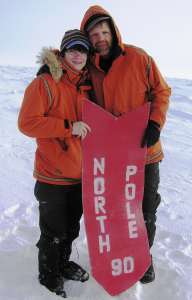To meet Paul Schurke in person is to forget that you are standing in the company of an Arctic explorer. He wears the crinkled eyes and bronzed face of a life lived outside, but he is cloaked in the quiet demeanor of someone habitually observing the smallest of nature’s details—a line of wolf tracks across a frozen lake or the first bright crocus blossom of spring.

The iconic Wintergreen hat perched on his head is the only nod to the adventurer underneath, a man who conducts life from the helm of a dog sled swishing through winter woods and slipping across the frozen tundra. And yet it is through his drive for adventure that Paul created a mainstay business in Ely and broadened the vision of canoe country wilderness to include the coldest, snowiest season of the year.
A Political Beginning
Paul found his way to dog sledding through what he likes to call the backdoor—political engagement. When he graduated from college in the late 1970s, the Boundary Waters Canoe Area was the stage of a great debate over ambiguities in the Wilderness Act of 1963. Proponents of motor use argued that their banishment from the wilderness would also banish the elderly, the blind and the disabled. Paul and his friend Greg Lais took issue with this notion, and in 1977 they set out to prove it wrong, traveling into the Boundary Waters with a mixed group of able bodied and disabled campers. A New York Times reporter accompanied them, and the success of the trip was a political score for the case against motors. But for Paul and Greg it was also the turning point in their careers.
Sensing they were onto something big, the men launched Wilderness Inquiry (WI) as an organization dedicated to making wilderness accessible to everyone. Demand quickly outpaced the pair’s ability to accommodate canoe trips, and in less than two years they were setting their sites on winter as a way to serve more groups. That led them to dog sledding and a “recluse” by the name of Will Steger, living in a little log cabin, running Lynx Track Winter School and mushing dogs. He helped WI run its first dog sledding trip in 1979.
“I knew right then and there that winter was where it was at,” Paul says.

Winter was the optimal playground for physical and mental challenge—the perfect stage for what he sees as a great game of truth or consequence. He moved to Ely and immersed himself in dog sledding, becoming good friends with Steger and soon meeting his wife, Sue. By the early eighties Paul and Sue had taken over Lynx Track, and Paul left WI to Lais. The winter school became Wintergreen, and Sue launched a line of outdoor gear under the same name, outfitting Paul and Steger in her iconic red parkas on the first unassisted trek to the North Pole in 1986. Paul has returned four times since, including a trip to magnetic north, and he continues to guide clients across the globe by dog sled. This winter, he will lead groups through Hudson Bay’s Polar Bear National Park, the world’s largest birthing sanctuary for polar bears.
A Livelier Wilderness
Paul is almost nonchalant about his transition from mixed abilities canoe trips to dog sledding and arctic exploration. He sees it as the natural result of being a self-described edge seeker, building adventure into everything—even when that’s as simple as taking a new route home from town. But while his personal quest for adventure has taken him to the extremes of the earth, his business has played an important role in showing wilderness seekers closer to home that winter does not have to be a cold and scary place.
“Most [clients] think it will be an endurance test, that they will grin and bare it so they can tell stories when they get home. Most are pleasantly surprised by how comfortable they can be,” he says.
Dog sledding provides enough activity during the day to stay warm, and groups are rewarded for their efforts with a more personal wilderness encounter. Where canoe groups are lucky to see one or two animals per trip during the summer, Wintergreen groups cross paths with wildlife every day, coming across their tracks in the snow or actual sightings. And this “wilder and woollier” place comes without bugs, less gear (no need for that rain jacket) and no portaging. Most groups don’t even bother to set up the tents at night, opting instead to sleep out under the stars after a leisurely night in front of the campfire.
Uncertain Future
Yet for all the success that Wintergreen has achieved, Paul does not encourage his children to take over the family business. He has seen the mark of global warming across the northern landscape—polar ice once 10, 12 and 20 feet thick is now 2 or 3 at best, and in Ely, ice out occurs earlier every year, the crocus bloom two weeks ahead of schedule and the Tennessee Warblers arrive in May instead of June. As the ice disappears near the pole, Paul knows that the days of his projects there are numbered; where he used to count on a two-month window for trekking—March and April—he now relies on only a couple of weeks.
“So few of us have had an opportunity to witness this change. Our observations as laymen might differ from the government, but we see the impact not only on the landscape but on the towns and the Inuit. A few years ago, quite a bit [of media] focused on them. In the last year, [climate change] has accelerated on such as vast scale that the focus on the Inuit has been sidelined. The iconic figure of the polar bear and the sea hunting activities are still out there, but where decisions are being made they are largely ignored.”
It is this attention to the human and cultural story that makes Paul more than a thrill-seeker. He embodies a curiosity that influences his Arctic travels (which frequently offer clients the chance to meet Inuit and learn about their culture) as well as his treks closer to home in the Boundary Waters and Quetico. Paul recently canoed through Jack Fish Bay for the sole purpose of poking around on the forest floor for the foundations of an old village once located there.
“Suddenly, that point has a whole new dimension. And there are a lot of [places like that] out there. At one point there were between 3,000 and 5,000 people traveling through the [Boundary Waters] area—Native Americans, loggers, trappers. It was a lot of activity in what is now a quiet land. So many canoers pass by unaware.”
And that, perhaps, embodies Paul Schurke at his best: to simply be aware.
By Alissa Johnson, Wilderness News Contributor
This article appeared in Wilderness News Fall 2009

